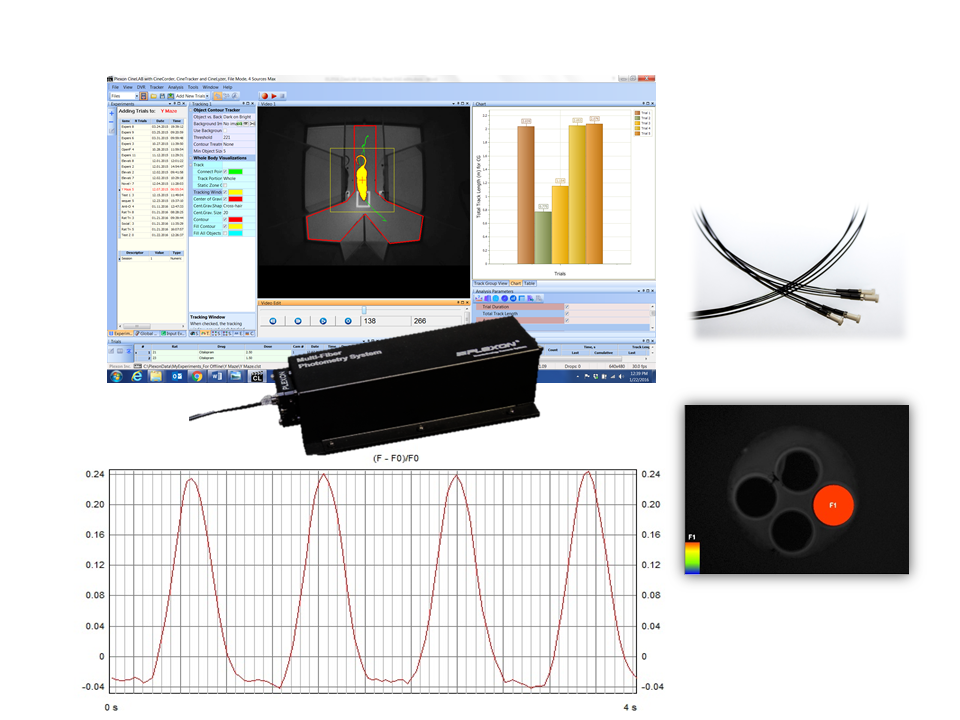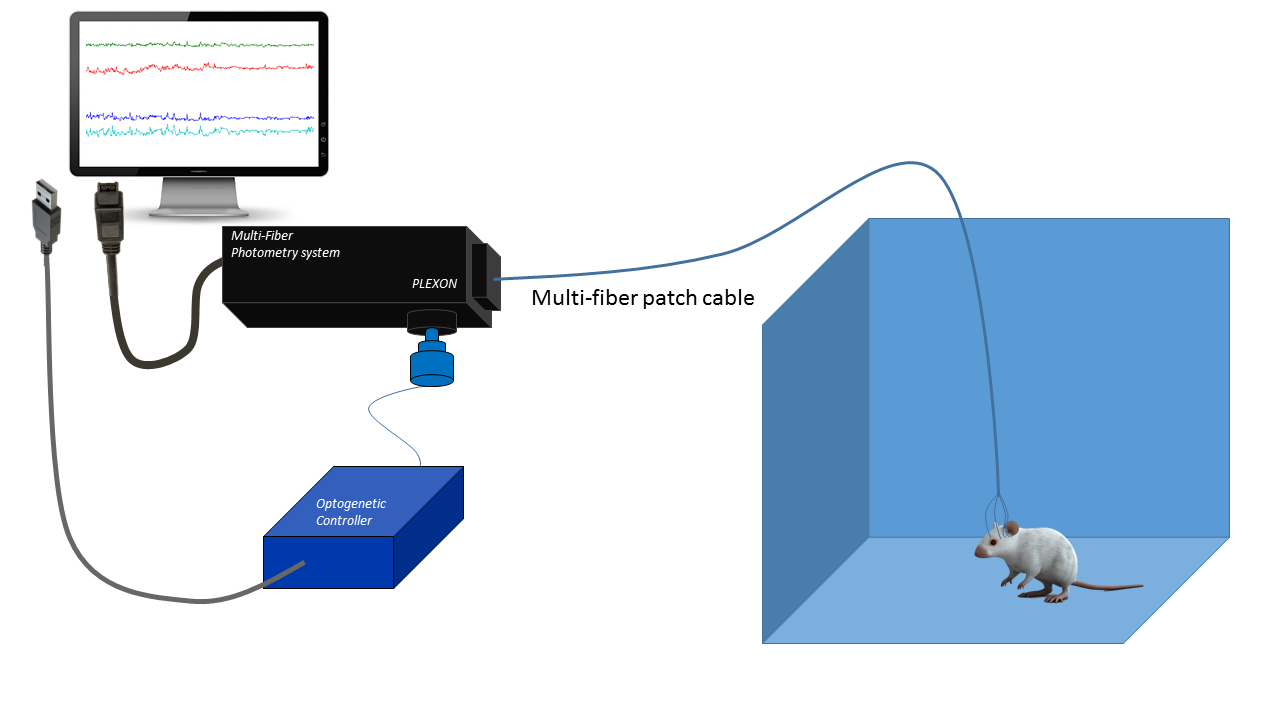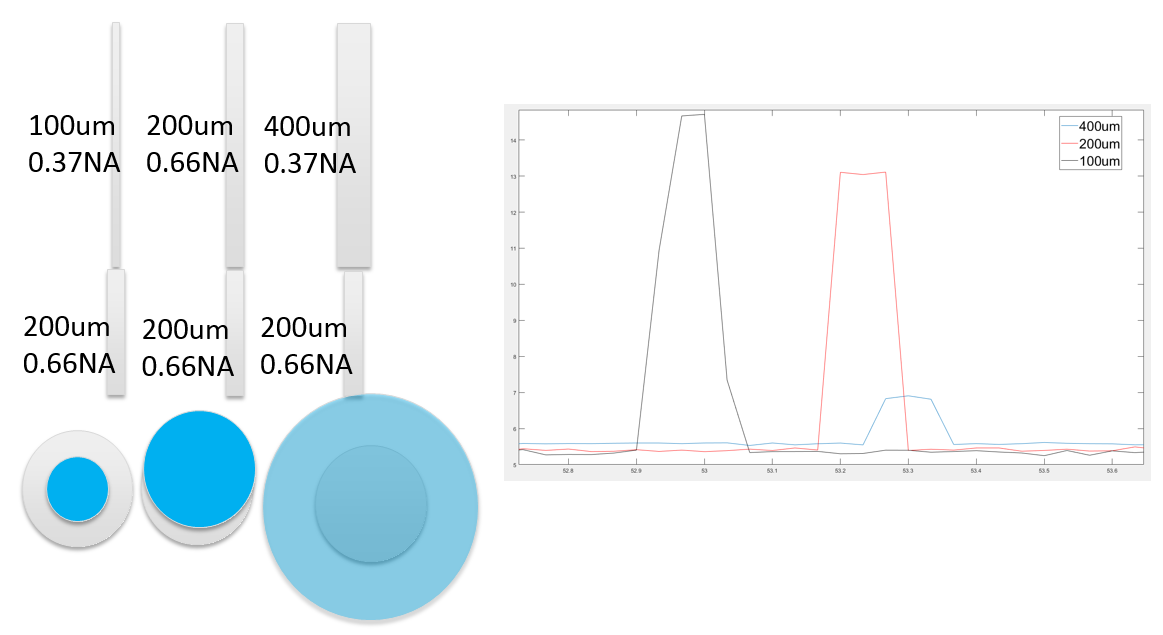CineLyzer with Single Wavelength Multi-Fiber Photometry System
The single wavelength multi-fiber photometry system is Plexon’s original camera based system that images one end of a branching patch cable containing multiple fibers and measures the photometry signal from the individual fibers in the bundle via image processing techniques. Although new single wavelength systems are no longer sold, support continues.
Features:
- Record from multiple locations in a single animal or many animals simultaneously with a single system
- Integrated with video tracking software
- Camera based
- GFP based indicators such as GCaMP6
- RFP based indicators such as R-CaMP2 (optional)


Plexon’s Innovation
By using a CCD camera through a fiber bundle, the channel number can be easily expanded without extra equipment. The single wavelength Multi-Fiber Photometry System is a camera based system that images one end of a patch cable containing a bundle of fibers and measures the photometry signal from the individual fibers in the bundle via image processing techniques. The other end of the patch cable consists of individual fiber branches that are typically connected to fiber stubs implanted into individual brain regions of interest or potentially even implanted into multiple subjects. An excitation light source is projected onto the bundled end of the cable and the excitation light travels down each individual branch to its respective brain region. Fluorescent reporters expressed in each brain region absorb the excitation light and emit an activity dependent light signal that travels back up the fiber branches to be imaged by the sensor.
The diagram depicts the basic components of CineLyzer with the single wavelength photometry system.
Coupled With CineLyzer
The single wavelength Multi-Fiber Photometry System is an optional subsystem that is integrated into the CineLyzer behavioral tracking and analysis system. The CineLyzer system provides for digital video recording of the subject along with speed, position, and orientation tracking. It allows you to define arenas and zones and compute statistical information on the subject’s entry into, exit from, or dwell time within these zones or sequences of zones. Dynamic zones centered on the subject can also be used to analyze social interaction between subjects. Thus incorporating photometry into the CineLyzer environment provides the information necessary to make correlations between the photometry signal(s) and the subject’s performance on behavioral tasks.
How is Plexon’s photometry system different from traditional systems?
The genetically encoded calcium indicators (GECIs), such as GCaMP** proteins, enable optical monitoring of the neural activity in real time. Fiber photometry provides the most sensitive and easiest way to record neuronal activities of the deep brain structures in behaving animals. Traditional systems employ a single multimode optical fiber implanted in the brain, a beam splitter that separates the excitation light and the fluorescent signals of neuronal activity indicators returning through the same optical fiber, and a photodetector. This approach allows for imaging of one fiber at a time. Measuring multiple brain regions is crucial to investigate connection between different brain regions to produce behaviors and the neural correlates of social interaction. Plexon’s camera-based approach provides a cost effective means to image from multiple fibers with the same detector.
**GCaMP is a genetically encoded calcium indicator that allows researchers to visualize changes in intracellular calcium in vivo. GCaMP can be used to tag cell-type specific neurons with engineered fluorescent proteins and then measure the levels of fluorescence in response to changes in intracellular calcium concentration. The fluorescence emission of the GCaMP indicator increases with elevating calcium concentration. Fiber photometry enables the researcher to record the neural activity of genetically defined subpopulations of neurons through an optic fiber in freely moving animals.
I am interested in recording from multiple animals simultaneously. Is this possible?
Yes, the branching patch cable terminates in 4 magnetic LC ferrules. Each of these ferrules can be attached to fiber stubs on different animals. 
What types of behavioral tasks can be used with CineLyzer and photometry?
- T-maze
- Fear conditioning
- Operant chamber
- Elevated plus maze
- Place preference
- Barnes maze
- Novel object recognition
- Social Interaction
- Radial arm maze
- Other behavioral paradigms
How do I know what type of fiber stubs I should use with my photometry system?
There are many options when choosing a fiber stub. Plexon recommends using fiber stubs with a diameter of either 200/225um or 225/245um, which are both larger diameters than the diameter of the fiber used in the branching patch cable. This combination allows for the highest average output in most cases. The diagram below illustrates the power output when various combinations of patch cables and fiber stubs are used. The depiction of the 100um patch cable with the 200um fiber stub is the solution that Plexon recommends for the highest average output.
What if magnetic fiber stubs will not work with my experimental design?
The magnetic branching photometry patch cable is made to easily attach to magnetic LC ferrules. However, this patch cable can also be connected to standard fiber stubs using a ceramic or metal sleeve.
Selected technical specifications for the single wavelength Multi-Fiber Photometry are provided below.
| Excitation wavelength | 470 (GFP), Coming Soon: 410, 560 (RFP), 630 nm |
| Emission wavelength | 500-530nm, Coming Soon: 414-450nm, 580-611nm, 660-800nm |
| Resolution | 656 (H) x 492 (V) |
| Max frame rate at full resolution | 60fps |
| Quantum efficiency (monochrome) | 78% |
| Sensor | Sony ICX618 |
| Interface | IEEE 1394b Firewire 800 |
| Pixel size | 5.6 um x 5.6 um |
Installation Packages/Upgrades
- CineLyzer® 4.4.1 Windows 7 and 10 – for single wavelength photometry and CineLyzer systems without a trigger box
Demo Software
*Installation Instructions: After download, open the location where the .exe file was downloaded, right click the file and then click “Run as Administrator” to ensure proper installation.
Manuals/User Guides
- CineLyzer Behavioral Research System User Guide
- CineDemo Quick Start Guide
- Photometry Quick Start Guide (single wavelength)
Change Log
Technical Specs and Data Sheets

